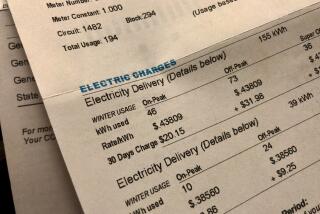Some Analysts Keep ‘Buy’ Ratings on Edison, PG
NEW YORK — Brokerage giant Goldman, Sachs & Co. put PG&E; Corp. and Edison International on its “recommended” list last summer, and has kept them there.
Even though the companies could be headed for bankruptcy, Goldman utility analyst Jonathan Raleigh is telling clients to stay put--or even to buy more.
At this point, Raleigh said, a “long look at the stocks” convinces him that they are a good value at current prices. “There’s still a lot of activity in the [state] legislature that could turn things around,” he said.
That is a controversial view, however, as the California power crisis worsens and bankruptcy looms as a serious possibility.
On Friday, the state indicated it will seek to stop the utilities from trying to protect shareholders by shielding selected assets from bankruptcy.
Yet among Raleigh’s peer analysts on Wall Street, “sell” still is a rarely heard word when it comes to PG&E; and Edison. Critics say that reflects, in part, brokerages’ reluctance to ever recommend the outright sale of a stock, for fear of offending potential corporate clients.
Raleigh put Edison and two other utilities on Goldman’s “recommended list” on Sept. 12 after sifting though dozens of companies and presenting his ideas to the firm’s stock selection committee.
Two weeks later he added PG&E;, which had been rated “market perform.”
Though both Edison and PG&E; began to plunge in December, Raleigh said he stuck to his rating because he expected California’s politicians and regulators to fix the state’s electricity market before it reached a crisis.
Instead, “everything that could go wrong in California did go wrong,” he said. The state’s deregulation plan has left the companies with a deficit of more than $11.5 billion incurred by purchasing wholesale power at higher prices than they are allowed to charge retail customers.
Edison now is at $8.94 a share on the New York Stock Exchange; PG&E; is at $10.19.
Yet, even if the companies file for protection from creditors, Raleigh said, “I think that you have more than 10 bucks of value in [each company’s] unregulated subsidiaries.” Both companies have units that build and operate power plants in deregulated markets outside of California, he said, and profit from those units alone could justify the stock price.
But on Friday, California Atty. Gen. Bill Lockyer said he will try to stop PG&E; from shielding non-regulated affiliates in a new entity that would be set apart from the utility unit.
Henry Cavanna, who manages about $7 billion at J.P. Morgan Fleming Asset Management, sold all his PG&E; shares and is “not going to touch” either stock until there is some clear plan for how the companies avoid bankruptcy.
PG&E; and Edison shares have farther to fall if the companies seek protection from creditors, according to many investors, lawyers and Raleigh’s competitors.
When a company goes bankrupt, “equity holders often end up with nothing,” said Eric Brunstad, a partner in the financial and restructuring group at the law firm of Bingham Dana in Hartford, Conn.
Holders of common stock will be last in line to recover their investment, Brunstad said, after holders of bonds or preferred stock who have a claim on a company’s assets, and then most other creditors.
Amid the bankruptcy threat, Raleigh is the only analyst who still has a “strong buy” or equivalent rating on the companies.
Among the 19 analysts who track PG&E;, four rate the shares “buy,” which is a notch below Raleigh’s opinion. Edison has five “buys,” also out of 19 analysts. One analyst on each stock rates it a “sell.”
The rest of the analysts covering PG&E; and Edison rate them “hold” or “neutral,” generally the lowest rating used by Wall Street firms--and often an unspoken signal to sell.
Holders of El Paso Electric’s common stock got almost nothing when that company emerged from a four-year bankruptcy in 1996, said Paul Patterson of Credit Suisse First Boston, who rates both Edison and PG&E; “neutral.”
Patterson said the chances of the companies avoiding bankruptcy are “50-50” at best. If they do file for bankruptcy, or if they are forced to by their creditors, the shares of both companies “would go down from here,” he said.
In El Paso Electric’s case, unsecured creditors got 85% of the reorganized firm and preferred shareholders got 12%, while holders of common stock got just 3%.
An investment in Edison or PG&E; stock poses “more risk than what the individual shareholder in mainstream America should be looking for,” said Brian Youngberg, who covers Edison for brokerage Edward Jones in St. Louis.
Youngberg on Thursday cut his rating on Edison to “sell” from “hold,” making him the only analyst to formally recommend that investors dump the stock. Though he does not publish an investment opinion on PG&E;, Youngberg said his concerns apply to both.
Youngberg said his “sell” rating on Edison was motivated in part by the knowledge that his firm serves individual investors, rather than professional money managers. His clients include some who have owned Edison for “many, many years and have relied on the dividend income to live on,” he said.
Edison and PG&E; have both suspended dividend payments as they fight to conserve cash.
The only “sell” on PG&E; is from Carol Coale of Prudential Securities, who cut her rating from “hold” on Jan. 4.
More to Read
Inside the business of entertainment
The Wide Shot brings you news, analysis and insights on everything from streaming wars to production — and what it all means for the future.
You may occasionally receive promotional content from the Los Angeles Times.










